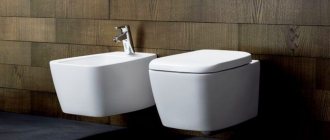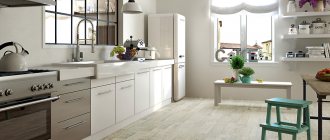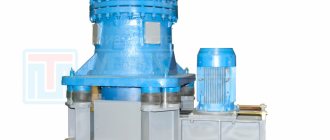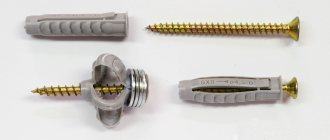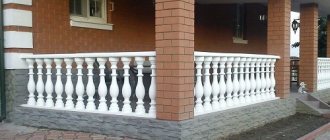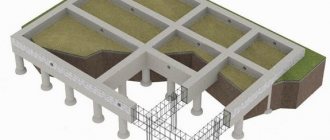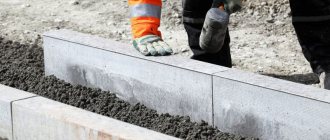Toilet bowl Genoa: its features
The Genoa Cup is the so-called floor or Turkish toilet, which involves squatting. This toilet is intended for use in sanitary facilities and toilets in various public places. For example, at train stations, airports, stadiums, schools, shops, cafes, hospitals, hotels and industrial buildings. For example, such a toilet is appropriate in both short- and long-distance trains.
Turkish toilet at the airport
The Turkish Genoa bowl toilet has found such wide application due to its lightness throughout its entire service life and resistance to various physical and technical damage. In addition, the advantages of the Genoa bowl toilet include:
Although the genoa bowl - floor-standing toilets have a drawback. This is the need to squat, which, in turn, requires balancing and some coordination (see the article “Floor-mounted toilet: pros and cons”).
For installation in latrines, carriages, vehicles and soldiers' barracks, manufacturing companies offer to buy a genoa bowl toilet of a special device with a flange.
To find out which brand of floor-standing toilet is better, see the review article at the link: https://remontspravka.com/unitas-floor-best/
For a review of stores where you can buy a good toilet, see here.
Currently, the most popular materials for the production of Genoa bowl toilets are cast iron, ceramics and steel. However, despite the different types of Turkish toilets, they are all essentially a hole in the floor.
Although today there are also genoa bowls and floor-standing toilets that have not only footrests, but also seats. This allows a person to use it at will - sit upright or squat. So, for example, the “high” carriage toilet has footrests hidden under the thickenings in the front part so that you can also squat.
Toilet with hidden squatting footrests
By the way, you can also squat on regular home toilets, although this requires caution and some dexterity.
The Genoa bowl toilet is common in Asia, mainly in Japan and China, as well as in Muslim countries and in many public toilets in the countries of the former USSR. Particularly popular is the cast iron floor-mounted Genoa bowl.
Why is the Turkish Genoa bowl common in Islamic countries? There is a cultural tradition of squatting (or sitting). Because according to Islamic toilet etiquette, it is forbidden for legitimate Muslims to urinate while standing. Sometimes a hose is installed near the toilet for cleaning, similar to a shower.
Floor-standing toilet for Muslims
Types of flush toilets
Depending on the direction of water flow, toilet designs are divided into two types:
- direct or cascade type of flush;
- reverse circular flush type.
Direct flush device. Each of the designs has its positive and negative sides. Below we will analyze in more detail the structure of each of the flushes.
The principle of direct flushing is a one-way flow of water through the bowl. From the point of view of durability, such a flush is the most durable compared to a circular one, but the efficiency of such a flush is worse.
The advantage of toilets with this flush is its low price.
The downsides are:
- incomplete circumference of the bowl;
- noise;
- splashing.
Circular flush device. The principle of operation is to organize a circular flushing system. Streams of water move in a circle, because... initially directed at different angles. This cleaning method allows you to treat about 95% of the internal surface. In addition, the cleaning process is not accompanied by noise.
There is also a non-standard flush, which involves first filling the bowl with water and then immediately draining it. This option completely covers the entire surface of the bowl.
But it was not without its drawbacks. This is a large consumption of water, the volume of which exceeds 8 liters, when standard indicators should not exceed 6 liters.
The presence of two drain modes - full drain and economical, water costs will be halved.
Other differences depend on the location of the sewer system and the fastening of the structure.
Turkish toilet bowl Genoa: its types
1) Cast iron floor-standing toilet bowl Genoa (enamel). Today this type of Turkish toilet is rarely seen on sale. Of all types, it has the highest price, but at the same time the greatest durability - about 50 years and resistance to corrosion.
Floor-standing cast iron toilet
2) Genoa bowls and floor-standing toilets made of enameled steel successfully combine strength and price. The cost of a steel Turkish toilet is at the level of a similar ceramic product. Although its strength is much higher, it is steel after all. However, this is its downside - the Genoa steel bowl bowl has the least corrosion resistance compared to other types.
Advice! Before you buy a genoa bowl toilet made of steel, be sure to compare the thickness of the metal from different manufacturers. The thicker it is, the tougher and stronger the Turkish toilet.
For detailed instructions on how to install a toilet with your own hands, see the link: https://remontspravka.com/floor-unitas-montage/
You will also find information on how to properly renovate a toilet on our website.
3) Floor-standing ceramic toilet. The advantages of the Genoa ceramic bowl toilet include low cost and aesthetic appearance. In addition, it is durable - from 10 to 15 years and is easy to clean (see the article “The best way to clean a toilet”). However, such a toilet will not withstand strong mechanical and physical impact. For example, if a heavy object falls on a ceramic floor-standing toilet, a crack may appear.
Floor-standing ceramic toilet
Tank mounting options
There are several options for placing the flush cistern, but depending on the connection with the toilet, there are separate and joint types of construction.
Separate toilet and cistern
The tank is mounted under the ceiling and connected to the toilet with a plastic or metal pipeline. The drainage device is controlled by a lever, which is extended by a flexible handle on a chain, rope or similar material. The design was developed more than a century ago and has the advantage of a naturally high drain rate, which ensures high-quality performance compared to other analogues.
Modern separate systems are installed with a hidden tank, which in the open version does not have an aesthetic appearance, but there are also decorative options.
Shared toilet and cistern
The joint design (compact) involves attaching the tank directly to the toilet or to a monolithic shelf. This system is widespread because it does not require additional installation work and involves less use of materials. In addition, the compact can be positioned regardless of the distance to the walls and the ability to use vertical surfaces as a load-bearing base.
The most common option for attaching a toilet tank.
Monoblock toilet
This is a kind of toilet combined with a tank, but the tank is not attached to the toilet using bolts and a rubber seal, but the entire block is cast at once.
This design is more reliable and hygienic, but it is more cumbersome.
Hidden tank
To implement design solutions or to increase space in the toilet room, modern flush cisterns can be mounted hidden using a false wall. The tank must be made of plastic, and the device must be installed using the frame method. Buttons or control levers are brought to the surface using special mechanical extensions, which are provided by the design of the tank.
Most often, such a system is used when installing wall-mounted toilets.
Toilets without cistern
In modern plumbing equipment, especially for the installation of public toilets, toilets with a drain system directly from the pipeline are used. Water is supplied from the mains and controlled by a mechanical or electronic valve.
Genoa bowl toilet – affordable price!
When purchasing a Turkish toilet, as a rule, you also buy related products, namely: a tank, a siphon, a mixer, an installation, a flush tap, etc. Many online stores offer to buy a Genoa bowl toilet and accessories for it (see the article “Where is the best place to buy toilet fittings"). For example, a floor-standing toilet can be purchased on the website (https://www.trubmarket.ru/santekhnika/sanfayans/chasha-genuya-i-komplektuyushchie/). In this online store you can purchase a Genoa bowl toilet, the price of which is very low, regardless of whether you buy wholesale or retail.
Manufacturers
We present a short overview of the most popular brands of floor-standing toilets on the Russian market.
Roca
This Spanish international company began its activities in 1929. Since 2004, a subsidiary of the Roca Group has been successfully operating in Russia.
Advantages of floor-standing toilets:
- Environmental friendliness;
- There is an anti-splash system;
- Wide range of models;
- Prices from 2,000 to 500,000 rubles.
Flaws:
- Problems with the seat mechanism;
- Noisy water drainage;
- Poor rinsing.
Vitra
The largest plumbing concern in Turkey produces a variety of products for bathrooms and toilets, which are in wide consumer demand.
Advantages:
- Functionality;
- High-quality fittings;
- Optimal forms;
- Economical drainage system;
- Large selection of models;
- Budget options;
- Cost 2000-30000 rubles.
Flaws:
- Weak drainage system.
Jika
A popular Czech brand in many countries around the world. Their first plant for the production of toilets and other sanitary ware was founded in 1878.
Pros:
- Reliability;
- Ease of use;
- Compact dimensions;
- A large assortment;
- Affordable prices: 1000-12000 rubles.
Minuses:
- Lack of seating;
- Expensive repairs.
Cersanit
Polish leader in the production of sanitary equipment. They specialize in comprehensive products for bathrooms and powder rooms.
Advantages of Cersanit toilets:
- Quality materials;
- Easy to maintain;
- Reliability;
- Price range 1500-10000 rubles.
Flaws:
- There is no anti-splash;
- Weak flush system.
Gustavsberg
Swedish floor-standing toilets of this brand have been produced since 1939. The materials used are both porcelain and earthenware.
Their advantages:
- Ergonomics;
- Ease of maintenance;
- Silent operation of the cistern;
- High-quality fittings;
- Long-term warranty (25 years);
- Excellent drainage system;
- Cost from 3,000 to 20,000 rubles.
Related article: Building a bathhouse with your own hands (step by step)
Flaws:
- There are fakes;
- Not sold everywhere;
- Not all service centers are serviced.
Sanita
Russian stamp from the city of Samara. The production has been operating since 1944. The first Soviet plant where porcelain casting technology began to be used and nothing else is used besides it.
Advantages of floor-standing toilets of this brand:
- High quality porcelain;
- High-quality fittings;
- Excellent flush system;
- Reasonable prices: 2000 – 8000 rubles;
- Classic design;
- Self-cleaning coating on some devices.
Flaws:
- Lack of anti-splash system;
- Unreliable seating mechanism.
Genoa bowl or toilet: which is more dangerous to health
The “ancestor” of the modern toilet, on which we sit like a chair, was the first flush device in human history with a cistern, which was invented in 1596 by a man named John Harrington. It cannot be said that this new product immediately gained popularity, so great was the power of habit. At all times, a person relieved his great need, squatting, and, at best, over a hole in the floor - a prototype of the modern Genoa Cup. Until the mid-19th century, the chair-like toilet was only available to the richest and most powerful people, such as members of the royal family.
The earliest toilets appeared in Ancient Egypt. Wealthy Egyptians used toilets with limestone seats. Others sat on what looked like a wooden chair with a hole and a container of sand underneath it. Egypt's hot climate and water shortages hampered the development of sewer systems. Some ancient civilizations in the same era created quite advanced drainage systems: for example, in the Indus Valley more than 2000 BC. e. They were already flushing the toilets with water, but they continued to squat and use the holes in the floor. The Romans built public toilets with stone seats. The houses of wealthy citizens had their own bathrooms with plumbing.
In the Middle Ages, toilets in the form of holes in the ground with wooden seats above them prevailed. In the 12th century, monks began building stone and wooden toilets with gutters leading into the sea or river. Most people in those days used pots. The first public flush toilet was opened in London in 1852. Many rural residents in various countries continued to use latrines and outhouses until the late 1960s.
The tradition of squatting to relieve oneself is considered Asian, since in many of these countries it has been preferred until now. And not at all because of the poverty of the residents, but for reasons of health benefits. Countries such as Japan, Indonesia, India, Bangladesh, Pakistan, China, North Korea, South Korea, Singapore, Sri Lanka, Thailand, Malaysia, Myanmar and Iran continued to use the "Asian style" of defecation long after sit-down toilets became widespread.
And many scientists and doctors consider this position to be more natural for humans. And recent studies confirm its advantages over sitting on the toilet.
In 2015, Israeli researcher Dov Sikirov decided to prove that defecation in a squatting position is significantly more physiological than in a sitting position. The study involved 28 healthy subjects aged 17 to 66 years, who were asked to perform their bowel movements using toilets of different heights (42 cm and 32 cm), including a plastic container in which they were told to squat. Participants then recorded how long it took them to have a bowel movement and how difficult the process was in each position. The results showed that the average time for squatting defecation was 51 seconds, and the average time for the lower and upper toilet seat positions was 114 and 130 seconds, respectively. Further research has also suggested a link between toilet sitting and a range of complications, from heart attacks to hernias and colon cancer.
Another study the same year was conducted by a Japanese team of scientists from the Department of Neurology at Toho University Medical Center and the Department of Urology at Tokyo Medical University. Determined to understand how body position affects bowel movements in humans, the researchers said that squatting is much safer and more comfortable than sitting on the toilet. Six volunteers filled their rectum with a contrast solution and were then instructed to release the liquid in different body positions. The researchers found that squatting increased the width of the anorectal angle, which resulted in less abdominal tension in the participants.
A separate study by Pakistani researchers found that those who squat to defecate experienced significantly less symptoms of chronic anal fissures. 100 patients with signs and symptoms of chronic anal inflammation were examined. Researchers' conclusion: Changing bowel habits using a Genoa cup results in complete rectal emptying in a shorter time and with less force required. This leads to a reduction in symptoms and cure of a chronic anal lesion.
Why is it called a genoa bowl, tips for choosing and installing a floor-standing toilet
Among the variety of toilets used in private and public toilets, one can especially highlight the type called the “Genoa bowl”. The scope of application of such toilets is determined, first of all, by their design features. The lack of comfort is fully compensated by mechanical strength and high anti-vandal properties.
This review discusses the main types, features of installation and operation of the Genoa bowl, and also identifies the most likely area of application. The advantages and disadvantages of built-in floor-standing toilets will be analyzed separately.
What is the "Genoa Cup"?
There are several versions of the name, but the most plausible is the following: the prototype of the modern Genoa bowls was first installed in a public restroom in the Italian city of Genoa, where the name came from. Another name, “Turkish toilet,” is associated with the wide distribution of this type of plumbing in the east and central Asia.
As for the scope of application, the Genoa bowl can rarely be found in a private house or apartment. This is due to the lack of comfort during use: to use a toilet of this design, you need to sit down and remain in this position for quite a long time, which is very tiring and uncomfortable.
However, these disadvantages quickly turn into advantages when it comes to public toilets, medical, children's, administrative and other institutions where a large number of people use one bathroom.
This is explained quite simply: when using a Turkish toilet, there is no need for a seat, which, without exaggeration, can be considered an item of personal hygiene. In addition, installing a “Genoa” bowl in public toilets almost completely eliminates the possibility of acts of vandalism and mechanical damage to plumbing. Thanks to these properties, built-in toilets are installed in:
The device of the Genoa bowl
A standard set of elements for a floor-standing toilet consists of the following structural elements:
Drain tank.
The container can be mounted on the wall, directly above the toilet, walled into the wall or hidden by a partition. The last two options provide the maximum degree of anti-vandal protection and a decorative component: with this installation, only the water release buttons are visible. The most common are mid- and high-mounted flush tanks, which are connected to the bowl by a long pipe.
Flush tap.
This element is an alternative to the drain tank and is also designed to clean the bowl with running water. The drainage system is connected directly to the water supply, and the water supply to the bowl is regulated by a special valve. The main advantages of such a system are:
The disadvantages include the drain valve losing its functionality in the absence of pressure in the line. However, this drawback can be considered conditional, since if there is no pressure in the centralized water supply system, the drain tank will also not be filled.
Siphon.
Such an element is provided when installing any toilet, not just the “Turkish” one. The main purpose of the water seal is to drain the contents of the bowl into the main sewer branch. In addition, thanks to its design features (meaning a bend that is constantly filled with water), the siphon allows for the localization of unpleasant odors that can penetrate into the room from the sewer system. There are three types of water seals:
The choice of configuration is determined by the design features of the toilet.
Installation system.
This spatial structure is made of durable, corrosion-resistant materials. The installation frame is designed for mounting individual elements of the Genoa bowl system, in particular the drain tank and the bowl itself, if it is mounted on a podium. The load-bearing capacity of the installation system is more than 200 kg, which ensures reliable fastening of the toilet itself and additional elements. Given the increased load, the frame is installed exclusively on load-bearing surfaces. Often the entire structure, together with the cistern, is masked with a partition made of plasterboard or other material in such a way that only buttons or a valve intended for flushing remain outside.
Types of toilets for release into sewer systems
Depending on the type of water drainage, they come in several types:
- with vertical outlet;
- with horizontal;
- with an oblique
Therefore, the choice also depends on the sewer outlet in your premises.
Oblique and horizontal outlets have a slight difference - this is the angle of inclination, in the first case it is located horizontally, and in the second, with an oblique outlet, the angle is 40 - 45° relative to the sewer hole.
In recent years, these types of toilets have become the most popular due to the fact that sewerage is laid inside the ceilings, which are combined into a common system of vertical risers.
Let us examine in more detail each type of sewer outlet.
Oblique bend. This outlet became very popular in the 70s and 80s of the last century; toilets with such an outlet began to be used in apartment buildings. With an oblique drain, the angle of inclination is 40 - 45 degrees relative to the sewer hole.
Horizontal outlet . Most modern toilet designs are designed with horizontal drainage in mind. The outlet of the toilet is located horizontally.
Vertical outlet . This descent is most typical for buildings of the first half of the last century. This design is popular in America, this is due to the fact that communications are installed there without being attached to the walls. Therefore, this method allows you to install plumbing fixtures in any chosen location, and the pipeline is masked using finishing.
What material to choose a Genoa bowl from?
Currently, there are four most common materials from which Turkish toilets are made, these include:
Each of these materials has its own characteristics, advantages and disadvantages; let’s consider them in more detail.
Cast iron
Cast iron is a material used for the manufacture of plumbing fixtures since time immemorial. The first Genoa bowls were made from cast iron. This is due to high mechanical strength and long service life. At the moment, a cast iron bowl is the most durable and durable option. The disadvantages of cast iron plumbing include, first of all, its heavy weight; a Genoa cast iron bowl weighs approximately 15 kg, which significantly complicates delivery and installation.
Ceramics
Modern ceramic floor-standing toilets are made from sanitary porcelain and sanitary ware. By their nature, the materials differ little from each other and have common advantages and disadvantages. The advantages include relative lightness and high aesthetic qualities. Significant disadvantages are low resistance to mechanical stress and the need to use special detergents.
When comparing sanitary porcelain and sanitary ware, most professional plumbers prefer the former as it is more resistant to unpleasant odors and less susceptible to contamination.
Steel
Like cast iron bowls, steel floor-standing toilets have high strength and anti-vandal properties, and are also resistant to corrosion. Genoa bowls, made of stainless steel, are distinguished by their attractive design and variety of shapes.
In addition to these advantages, it should be noted that steel toilets can neutralize unpleasant odors to some extent. The impression is somewhat spoiled by the high cost and acoustic properties of steel floor-standing toilets. The fact is that the sound absorption coefficient of a steel bowl is very small; the sound of pouring water can be heard quite clearly.
With bidet
When there is little space in the bathroom, but you want to equip it with everything you need, you can install a shower toilet . The device has so many functions and capabilities - except that it doesn't fly. But its price is much higher than a regular toilet, but the expense is justified. As soon as the user occupies the seat, the built-in air purification system is automatically activated. The bidet function is activated by simply pressing the remote control button. The shower is mounted directly under the toilet seat and pulls out when needed. The water is supplied already heated to body temperature (the degrees can be adjusted manually), and the stream can be pendulum, pulsating massage or “lady’s”, adapted to the characteristics of the female body. Then the hair dryer is put into operation, which supplies warm drying air. But that’s not all, the higher the price of the equipment, the more functions it offers.
As an alternative and as a cheaper bidet option, you can purchase only a bidet lid , which can be of various modifications. Outwardly, it looks like a regular lid, but in the thickening of the rim there is a pipe that supplies water. These devices are universal and fit almost any toilet model.
Related article: How to properly paint timber yourself
Advantages and disadvantages of Genoa bowls
Using a Turkish toilet has its significant advantages and no less significant disadvantages. The undeniable advantages of floor-standing toilets are:
The main disadvantage of a floor-standing toilet, which limits its scope of use in apartments and private houses, is the complete lack of comfort during use. Constantly squatting is extremely tiring, and there is a risk of getting your clothes dirty.

